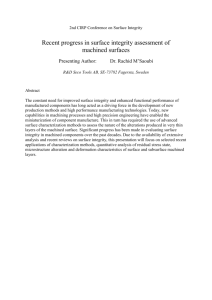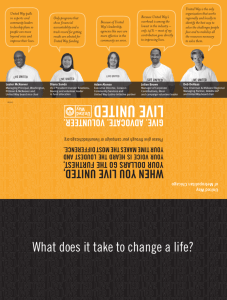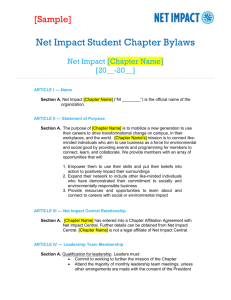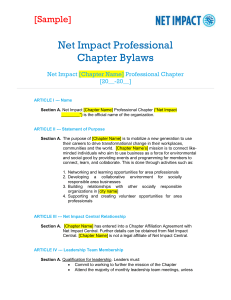Project Profile Machine Vices - DC-MSME
advertisement
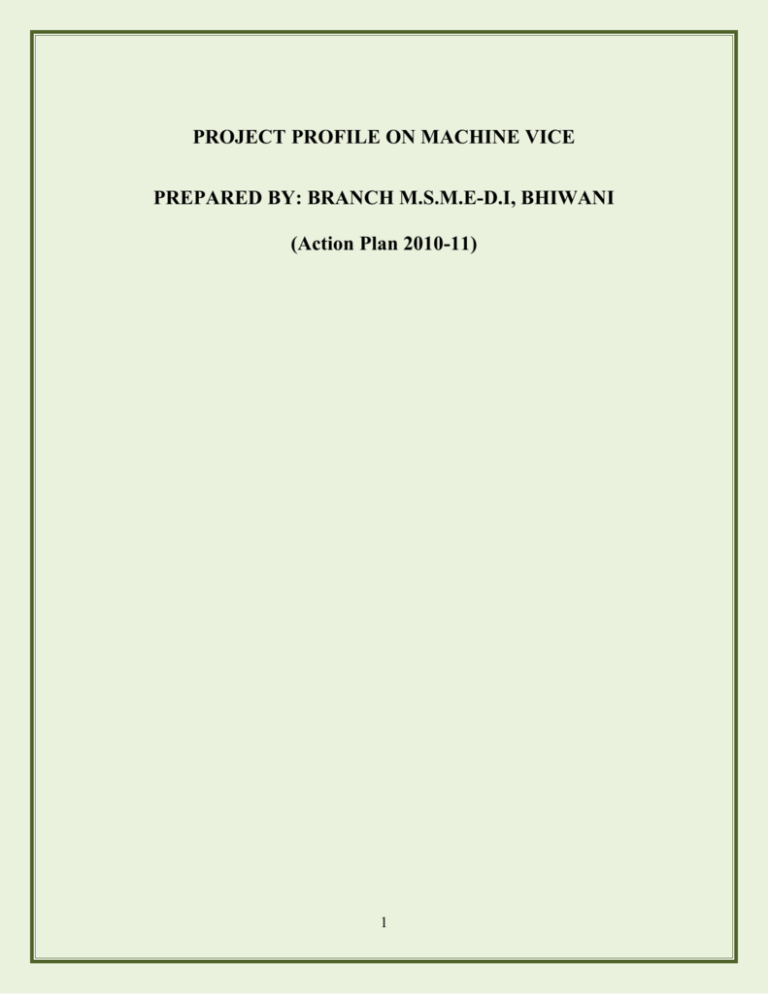
PROJECT PROFILE ON MACHINE VICE PREPARED BY: BRANCH M.S.M.E-D.I, BHIWANI (Action Plan 2010-11) 1 MACHINE VICES Introduction: Vices are used as holding device on machines like lathes, milling machine, drilling machine etc. and also by tool makers for holding jobs.Designwise three types of vices are very common in use namely plain vice, swivel vice and tool makers vice which is commonly known as bench vice. A. Plain Vices Plain vices bolted directly on the Milling machine table, is the most common type of machine vice used for milling operations. The vice may be fastened to the table with the jaws set either parallel or at right angles to the table T-slots. Work piece is clamped between the fixed and movable jaws. B. Swivel Vice The swivel vice is used to mill an angular surface in relation to a straight surface without moving the work piece from the vice. In construction it may be considered as plain vice which is mounted on a particular base graduated in degrees. The base is clamped on the table with the help of T.bolts. C. Universal Vice The universal vice can be swivelled in a horizontal plane like swivel vice and can also be tilted in any vertical position for angular cuts. The vice not being rigid in construction is mainly used in tool room work and hence is called as tool makers universal vice. Market Potential: The plain swivel vices are commonly used for all machining work on milling machine and also for drilling holes on jobs on drilling machines. These milling machines are essential in any workshops where the milling and drilling machines are installed. The number of work shops where milling and drilling machines are used are increasing due to rapid developments in industrial sectors. All the machine tool manufacturers get the vices made in small scale industries as a sub contracting work as standard equipments. Small Scale Industries also purchase the vices in the open market through dealers. With wide usage of milling and drilling machines the market for machine vices is increasing day by day. This shows that there is a good market for this item due to its usefulness. 2 Basis and Presumptions: (i) (ii) (iii) (iv) (v) (vi) The efficiency of the unit is considered 75% i.e. six hours working per shift of eight hours with 25 working days per month and 300 working days per year for full capacity utilization The unit is envisaged to achieve 75% capacity in 1st year, 80% in 2nd year , 90% in 3rd year and 100% in the 4th year of production Labour wages are taken as per those prevailing under the Minimum Wages Act. Interest rate for capital is taken @16% per annum. Margin Money Depends on the norms of financing institute Pay back period of the project is considered to be six years. Implementation Schedule: S.No. ACTIVITY PERIOD 1. 2. 3. 4. 5. Preparation of project report Selection of site Registration of SSI Availability of finance/loan Procurement, erection, commissioning and Trial run of machinery. Recruitment of labour 30 days 30 days 1 week 90 days 30 days 6. 2 months Some of the activities can be taken simultaneously. Technical Aspects Process of Manufacture: The main raw material required will be casting (body) and EN. 8 rods for screws and carbon steel plates for jaws etc. Plain Vice: It consists of the following items: (a) Base, (b) Fixed jaws (c) Jaw plates (d) Movable jaws (e) Screw and nut (f) Guides (g) Grid (h) Handle 3 The base with a fixed jaw forms one piece of casting and it is milled on milling machine. Firstly the base is milled as a reference and then all other portions are machined with reference to base after milling operation it goes for scraping. Jaw plates are machined drilled and tapped in-group to the required size. Movable jaw is also milled first on vertical milling machine and its sides are drilled and tapped for fixing jibs. The nuts and bolts are machined on lathe as per design specifications and inspected for their interchangeability. The guides are integral parts of base machine scraped (for dove tail). The jibs are machined, drilled, tapped and ground to suit the dovetail. The components manufactured are inspected and sent or assembly. The process flow is as under: Milling Drilling Tapping Grinding/ Machining (screws and nuts) Milling square on shanks Inspection Assembly Swivel Vice: Following parts are required for assembly of swivel vice (a) Circular base (b) Fixed jaw (c) Movable jaw (d) Jaw plates (e) Screw and nuts (f) Guides (g) Jibs The Circular base is made up of cast iron (special grade grey cast iron) & machined on milling machine. Firstly the base is machined and then all other parts are machined with reference to base. Secondly the circular T-slots are made for housing main body of vice over it. After these operations it is machined in degrees. 4 The body consisting of fixed jaws and guides is made of cast iron (special grade grey cast iron). This will be machined on all the required surfaces and then sent for scrapping / grinding. The movable jaw is machined; sides are drilled, tapped and screened to suit the jibs. The screws and nuts are machined on lathe and square shank on screw is machined on milling machine. As stated earlier the jibs which is integral part of body is also machined and scrapped. The process flow is as under: Milling – Scrapping – Milling – Tapping – Grinding – Machining – Milling Shank I Inspection – Assembly. Quality Control and Standards: Indian standards institution have formulated the specifications oh machine vices (machine tool) and its No. IS: 4502-1968. This specification covers interchangeability, dimensions, general requirement and permissible errors of punch and pulls type vices with fixed or swivel base. Production Capacity: There are three sizes of vices commonly used and they are 125mm, 160mm & 200mm both plane and swivel types. The market rates for these vices are as under: S.NO SIZE QUANTITY 1. 2. 3. 125mm. 160mm. 200mm. . . . . . . . . . SWIVEL . 20 . 30 . 30 PLAIN 20 30 30 The details of production & sales are as under : (a) 125mm plain 20 nos. (b) 160mm plain 30 nos. (c) 200mm plain 30 nos. (d) 125mm swivel 20 nos. (e) 160mm swivel 30 nos. (f) 200mm swivel 30 nos. @Rs. 3500 per pc. @ Rs. 4500 per pc. @ Rs.6000 per pc. @ Rs. 4000per pc. @ Rs.5500per pc. @ Rs. 7000per pc Total Rs. 70000 Rs. 135000 RS. 180000 Rs. 80000 Rs. 165000 Rs. 210000 Rs.840000 5 Pollution Control: Not required Energy Conservation: All measures to save power and use of energy efficient equipments are suggested. Financial Aspects: Fixed Capital: 1. Land and Building (Built up area-800 Sq. mtrs. Open area-500Sq,mtrs) 2. Machinery and Equipments: A) .Lathe (40 mm spindle,6 ft bed)complete B) .Vertical Milling Machine (With Standard Accessories) C) .Surface Grinder (1000mmx240mm) D) .Universal Tool Cutter Grinder E) .Column drilling m/c (50 mm capacity) F) .Universal Band saw G) .Double ended Pedestal Grinder (6 in) H) .Measuring Instruments I). Jigs and Fixtures J) .Office Equipments TOTAL Installation & Erection @10% TOTAL Rs.50,00,000 Rs.325000 Rs.650000 Rs. 140000 Rs. 350000 Rs. 250000 Rs. 80000 Rs. 40000 Rs. 50000 Rs. 80000 Rs. 75000 Rs. 2040000 Rs. 204000 Rs.2244000 Working Capital: 1. Personnel SALARIES A. Manager B. Accountant C. Steno/Typist D. Technical supervisors E. Inspector F. Skilled Worker (4Nos @4000) G. Semiskilled Worker (4 nos@3000) TOTAL Perquisites @15% TOTAL Rs.15000 Rs.7000 Rs.5000 Rs.7000 Rs. 5000 Rs.16000 Rs.12000 Rs.67000 Rs.10050 Rs.77050 Raw Materials: 1. C.I. Castings 4T @Rs.40/Kg.) Rs. 160000 6 2. EN-8 Rods37mmDia (1.00MT@Rs.125/Kg) 3. T Nuts, Bolts & Screws 4. Carbon Steel Plates Rs.125000 Rs.25000 Rs.40000 Utilities: Electricity consumption Rs.40000 Other Contingent Expenses (per month): 1. Postage &Stationary 2. Telephone 3. Consumable Stores 4. Transport 5. Insurance 6. Misc. Expenses Rs.2000 Rs.1000 Rs.5000 Rs.10000 Rs.6000 Rs.10000 Total Rs.34000 Total Recurring Expenses: Rs.501050 Total Working Capital (3 months) Rs.1503150 Total Capital Investment: Fixed Capital Working Capital (3 months) Total Rs.7244000 Rs.1503150 Rs.8747150 Financial Analysis: Cost of Production (per year) 1. Total Recurring Expenditure 2. Depreciation on Building @ 5% 3. Depreciation on machinery @10% 4. Depreciation on tools @25% 5. Depreciation on Office Equipment 20% Rs.6012600 Rs. 250000 Rs. 204000 Rs. 20000 Rs. 12000 6. Interest on Fixed Capital @16% Rs.1159040 7. Interest on Working Capital@16% Rs. 240504 7 Total Rs.7898144 Net Profit (per year): Turn Over –Cost of Production (=10080000-7898144) Rs.2181856 Net Profit Ratio: = Net Profitx100 = 2181856x100 Turn Over(per year 10080000 =21.6% Rate of Return: = Net Profitx100 Total Investment =24.5% = 1460344 x100 8747150 Break- Even Point: Fixed Cost: 1. Depreciation 2. Interst on Total Investment 3. Insurance 4.40% of salaries 5.40% of other contingent expenses Total B.E.P Rs. 486000 Rs. 1399544 Rs. 72000 Rs. 369840 Rs. 134400 Rs.2461784 =Fixed Costx100 Fixed Cost +Profit =2461784 4643640 x100 8 =2461784x100 2461784+2181856 = 53% Addresses of Machinery Suppliers: 1. M/s.Sant Machine Tools Corporation 2nd Street, Kalsi Nagar G.t.Road, Ludhiana. 2. M/s.Basant Mechanical Works 720-722,Industrial Area-B Ludhiana. 3 .M/s Birdi Mechanical Works G.T.Road,Miller Ganj Ludhiana 4. M/s Katbro Machine Tools G.T.Road,Miller Ganj Ludhiana 5. M/s Sargodha Machinery Corporation Near Manju Cinema,G.T.Road Ludhiana 6. M/s Pal Mechanical Works Street No 2,Partap Nagar Ludhiana Raw Material Suppliers: Raw material required in the manufacturing is available in all industrial towns of the country. 9


